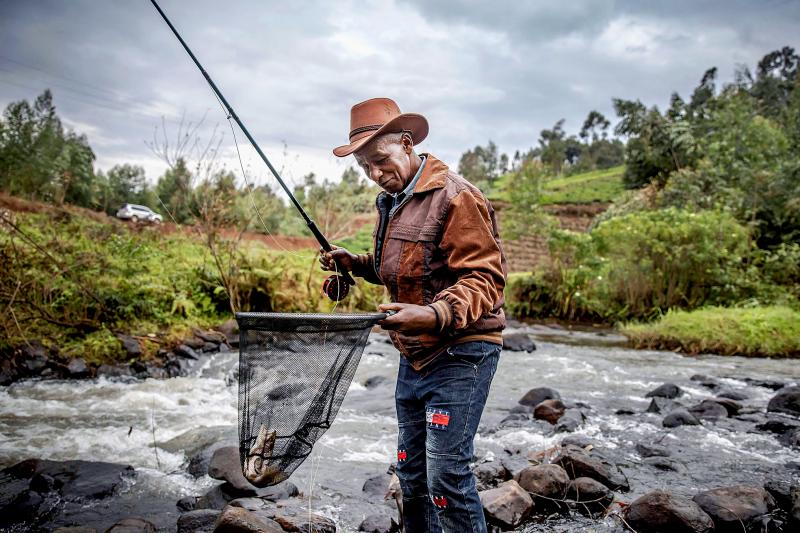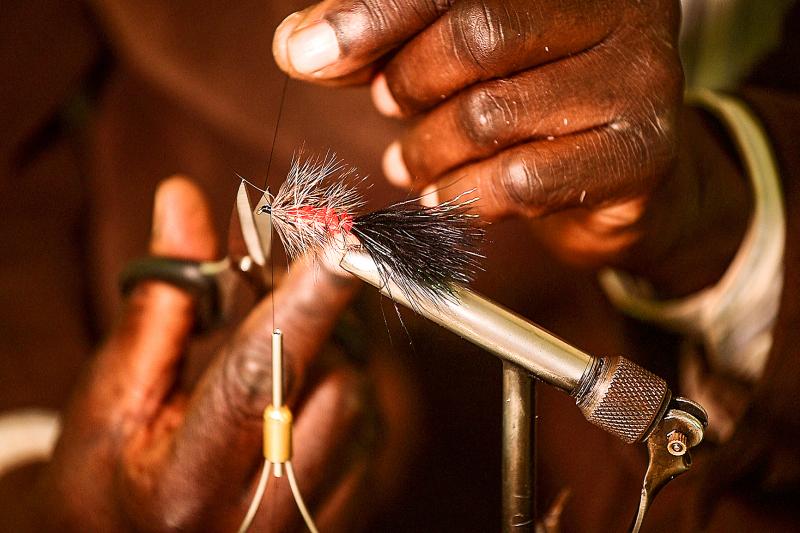With the nimbleness of a younger man, John Ngaii Moses skillfully knotted a tiny fishing fly onto his line and, hopping over mossy rocks, cast off into a surging river flowing through Kenyan tea country.
“I can tie a fly at night, without a light,” the 60-year-old fisherman said with a grin, flicking his line with a graceful arc into the pristine waters.
Moses is something of a rarity in Kenya, where fishing for recreation is neither popular nor widely understood, and even viewed warily as a vestige of colonial times.

Photo: AFP
Yet the country occupies a special place in the world of fly fishing, and enthusiasts believe demystifying the sport could create jobs and encourage future generations to protect rivers.
Kenya boasts one of Africa’s oldest fishing clubs, and a fly tying industry that for decades has supplied fishers from Norway to New Zealand with hand-crafted lures.
Visitors come from all over the world to fish in its highland rivers and alpine lakes, where the British introduced trout in the early 1900s.

Photo: AFP
Fish do not draw tourists like the big cats on Kenya’s savannas, but what is on offer for the intrepid fisher is no less remarkable.
Just two hours’ drive from Nairobi, where the Mathioya River crashes beneath the Aberdare Range, prime fishing country meets wilderness inhabited by black rhinos and elephants.
“Imagine spending the morning ... fishing and the afternoon out taking pictures of wild animals. Where else can you have this?” said Zac Gichane, owner of Aberdare Cottages and Fishing Lodge, a resort overlooking the Mathioya.
He said fly fishing was a multibillion-dollar global industry ripe for expansion in Kenya.
“It is God’s country. Two hours from Nairobi and you find crystal-clear rivers, a peaceful village, greenery... The opportunities here are limitless,” Gichane said.
Gichane sources his fishing flies from Kenyan crafters whose delicate and elaborate creations have become a mainstay for anglers worldwide.
These artificial lures — some so small they perch on a fingertip — are designed to imitate the particular insects that trout, salmon and other species feast on.
Moses prefers the “royal coachman” — traditionally dressed with feathers and a tail — because it resembles a butterfly native to the Mathioya that brings trout to the surface.
Reliable data is scant, but some estimates suggest one in three flies used in Europe originate in Kenya, while millions more are shipped to the US, Canada and other key fishing markets.
“It is a big business in Kenya. It employs a lot of people,” said John Nyapola, who owns Ojoo Fishing Flies Designers.
In his small workshop outside Nairobi, flamingo feathers, rabbit pelts and all manner of furs and fabrics litter an assembly table where custom orders from Canada, Australia and Japan are individually hand-tied.
“We have made them all,” said Jane Auma, a veteran fly tier with 32 years of experience, pointing to a well-worn catalog detailing 1,000 individual lure designs.
Their names — such as “Woolly Bugger,” “Copper John” and “Irresistible Adams” — are as baffling to most tiers as the sport itself.
“We do fish, but we don’t use flies. We use nets, and we try and catch everything,” Auma said, laughing.
Fly fishers, by contrast, mostly return whatever they catch to the river, to prevent overfishing.
Gichane said the catch-and-release ethos is considered “madness” by Kenyans who fish for food.
Some also dismiss the sport as a strange import.
Decades ago, the Mathioya valley was a hotbed of anti-colonial resistance, and suffered British reprisals.
Gichane said that before independence in 1963 — and even for a time after — many Kenyans would not dare pick up a rod.
“They think sport fishing is for mzungus [white people], not for Africans,” said Moses, who was born in a British internment camp, and is today a fishing guide.
The Kenya Fly Fishers’ Club, a private 102-year-old establishment on the Mathioya, has sought to broaden the sport’s appeal.
The club has welcomed more Kenyan members as interest has grown, and elected its first black chairman in 2018.
“Times are changing — same as fly fishing. Right now we have a lot of local, indigenous Kenyans who are fishing. I am one of them,” said Musa Ibrahim, a trustee and 20-year member of the club.
It has also reached out to local schools, to introduce children to fly fishing and its conservation aspects such as replenishing the Mathioya with trout.
Kenya at its prime was criss-crossed by 2,000km of unspoiled trout-fishing rivers, but rapid land conversion reduced that 10-fold, Ibrahim said.
“It’s up to us to make sure that we leave the legacy for the next generation,” he said.

CAUTIOUS RECOVERY: While the manufacturing sector returned to growth amid the US-China trade truce, firms remain wary as uncertainty clouds the outlook, the CIER said The local manufacturing sector returned to expansion last month, as the official purchasing managers’ index (PMI) rose 2.1 points to 51.0, driven by a temporary easing in US-China trade tensions, the Chung-Hua Institution for Economic Research (CIER, 中華經濟研究院) said yesterday. The PMI gauges the health of the manufacturing industry, with readings above 50 indicating expansion and those below 50 signaling contraction. “Firms are not as pessimistic as they were in April, but they remain far from optimistic,” CIER president Lien Hsien-ming (連賢明) said at a news conference. The full impact of US tariff decisions is unlikely to become clear until later this month

With an approval rating of just two percent, Peruvian President Dina Boluarte might be the world’s most unpopular leader, according to pollsters. Protests greeted her rise to power 29 months ago, and have marked her entire term — joined by assorted scandals, investigations, controversies and a surge in gang violence. The 63-year-old is the target of a dozen probes, including for her alleged failure to declare gifts of luxury jewels and watches, a scandal inevitably dubbed “Rolexgate.” She is also under the microscope for a two-week undeclared absence for nose surgery — which she insists was medical, not cosmetic — and is

GROWING CONCERN: Some senior Trump administration officials opposed the UAE expansion over fears that another TSMC project could jeopardize its US investment Taiwan Semiconductor Manufacturing Co (TSMC, 台積電) is evaluating building an advanced production facility in the United Arab Emirates (UAE) and has discussed the possibility with officials in US President Donald Trump’s administration, people familiar with the matter said, in a potentially major bet on the Middle East that would only come to fruition with Washington’s approval. The company has had multiple meetings in the past few months with US Special Envoy to the Middle East Steve Witkoff and officials from MGX, an influential investment vehicle overseen by the UAE president’s brother, the people said. The conversations are a continuation of talks that

CHIP DUTIES: TSMC said it voiced its concerns to Washington about tariffs, telling the US commerce department that it wants ‘fair treatment’ to protect its competitiveness Taiwan Semiconductor Manufacturing Co (TSMC, 台積電) yesterday reiterated robust business prospects for this year as strong artificial intelligence (AI) chip demand from Nvidia Corp and other customers would absorb the impacts of US tariffs. “The impact of tariffs would be indirect, as the custom tax is the importers’ responsibility, not the exporters,” TSMC chairman and chief executive officer C.C. Wei (魏哲家) said at the chipmaker’s annual shareholders’ meeting in Hsinchu City. TSMC’s business could be affected if people become reluctant to buy electronics due to inflated prices, Wei said. In addition, the chipmaker has voiced its concern to the US Department of Commerce